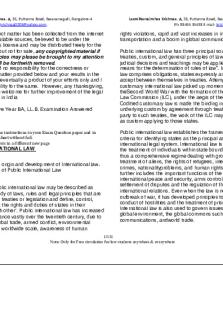LN 10 - Rotating unbalance PDF

| Title | LN 10 - Rotating unbalance |
|---|---|
| Course | Mechanical Vibration |
| Institution | University of Toledo |
| Pages | 5 |
| File Size | 1.1 MB |
| File Type | |
| Total Downloads | 94 |
| Total Views | 164 |
Summary
Download LN 10 - Rotating unbalance PDF
Description
Rotating unbalance Small irregularities in the distribution of the mass in the rotating component of a machine can produce substantial vibration. A rotating unbalance can be represented as a mass m0 rotating with an angular velocity ω r at a distance e from the center of rotation (Fig. 1). Therefore the x – component of the motion of the mass m0 is: xr = esin ω r t (1) Thus the x-component of the acceleration of the mass m0 is: ax = −eω 2r sin ωr t (2) Therefore the x-component of the force imparted by the structure is: Fx = −m0eω2r sin ωr t In Fig. 1, m is the total mass of the machine and includes the unbalance mass m0.
Fig. 1 Schematic of a rotating balance The equilibrium of forces on mass m yields: m x = −kx − cx − Fx or m x + cx + kx = m0eω 2r sin ω r t The steady-state solution (particular solution) of the equation of motion, Eq. (3) is: x p (t) = X sin(ω r t − θ )
where the amplitude is: X = the phase is: tanθ =
r2 mo e m (1 − r 2 )2 + ( 2ζ r)2
2ζ r 1− r 2
ωr . ωn The amplitude can be no-dimensionalized as:
and the frequency ratio is: r =
(3)
mX mo e
=
r2 2 2
( )
(1 − r ) + 2ζ r
2
.
A plot of the dimensionless amplitude versus the frequency ratio r is presented in Fig. 2.
Fig. 2 Dimensionless amplitude vs. frequency ratio From Fig. 2 it can be seen that: • The maximum deflection is less than or equal to 1 for any ζ >1 • For ζ...
Similar Free PDFs

LN 10 - Rotating unbalance
- 5 Pages

Utang LN
- 22 Pages

balancing of rotating masses
- 25 Pages

Mystification sociology ln
- 7 Pages

Rappels fonctions ln et e
- 2 Pages

PO107 - 12 Ideology (LN)
- 3 Pages

Ln hew nutrition final
- 97 Pages

PIL-8th Sem Q&A LN
- 131 Pages

LN 4 Modeling and Energy Methods
- 8 Pages

Determine la raíz real de Ln x
- 2 Pages
Popular Institutions
- Tinajero National High School - Annex
- Politeknik Caltex Riau
- Yokohama City University
- SGT University
- University of Al-Qadisiyah
- Divine Word College of Vigan
- Techniek College Rotterdam
- Universidade de Santiago
- Universiti Teknologi MARA Cawangan Johor Kampus Pasir Gudang
- Poltekkes Kemenkes Yogyakarta
- Baguio City National High School
- Colegio san marcos
- preparatoria uno
- Centro de Bachillerato Tecnológico Industrial y de Servicios No. 107
- Dalian Maritime University
- Quang Trung Secondary School
- Colegio Tecnológico en Informática
- Corporación Regional de Educación Superior
- Grupo CEDVA
- Dar Al Uloom University
- Centro de Estudios Preuniversitarios de la Universidad Nacional de Ingeniería
- 上智大学
- Aakash International School, Nuna Majara
- San Felipe Neri Catholic School
- Kang Chiao International School - New Taipei City
- Misamis Occidental National High School
- Institución Educativa Escuela Normal Juan Ladrilleros
- Kolehiyo ng Pantukan
- Batanes State College
- Instituto Continental
- Sekolah Menengah Kejuruan Kesehatan Kaltara (Tarakan)
- Colegio de La Inmaculada Concepcion - Cebu





